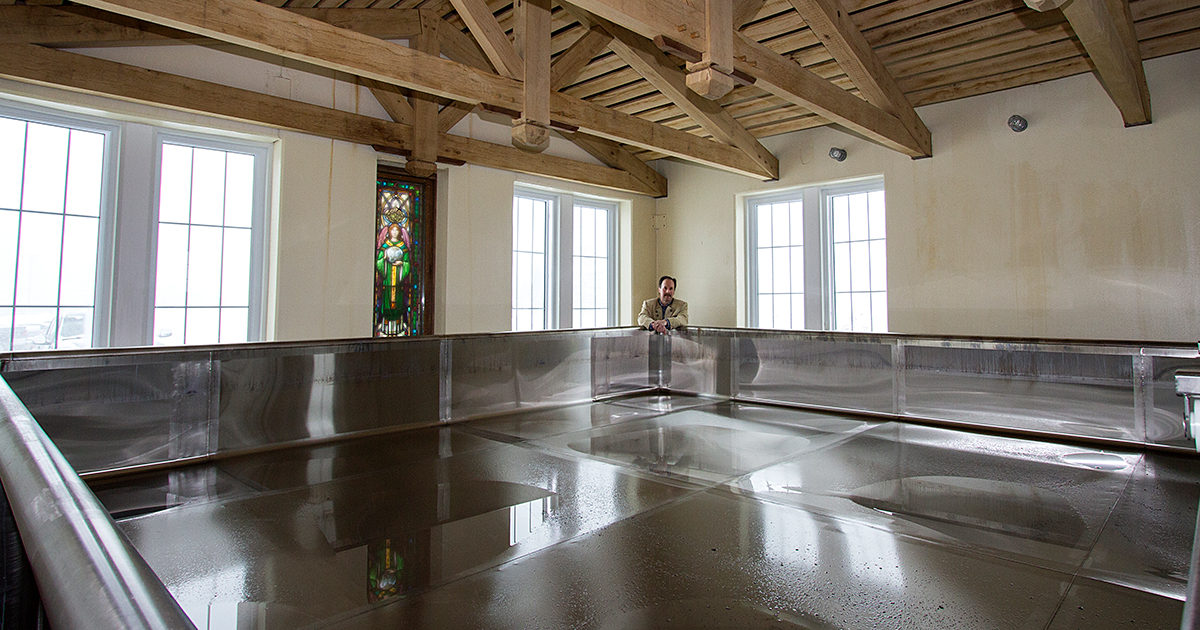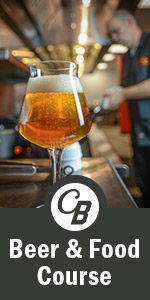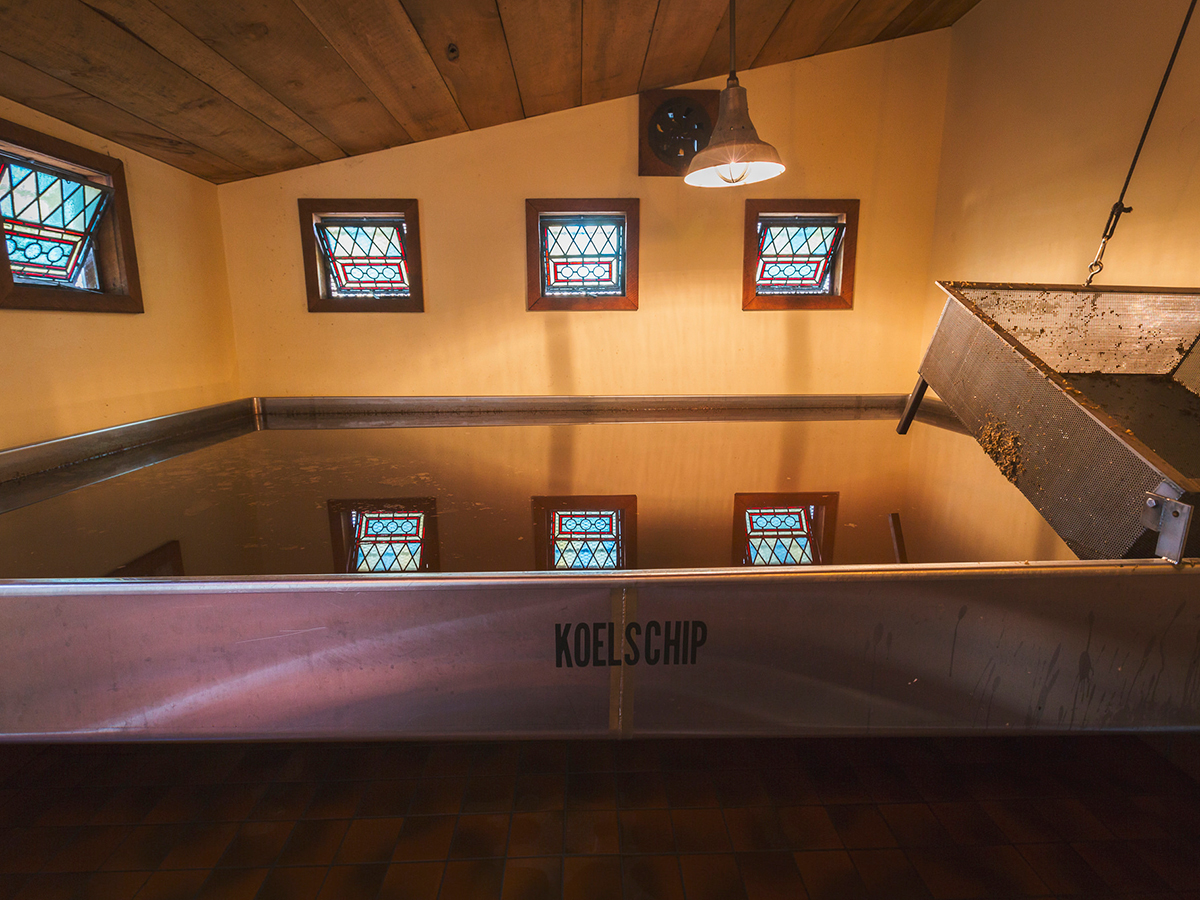What’s old is new. Coolships (koelschips in Flemish), dating back for centuries, are appearing in a growing number of craft breweries in what may be a mini-coolship fever, propelled by the explosion of interest in Belgian brewing styles and a harkening back to traditional brewing.
This iconic brewing equipment, usually made of either copper or stainless steel, looks like a giant brownie baking pan. Historically they were utilized to cool down the heated wort, the sugary liquid that ferments into beer, that is created when hot water is run through the milled malted barley, wheat or other grains.
(MORE: Pastors Find Second Calling in Craft Beer)
Before the advent of refrigeration and heat exchangers, coolships provided a large surface area to cool down the heated wort to a more moderate temperature where yeasts can survive and thrive, making alcohol, carbon dioxide and eventually beer. During those past times all beers were either tart or sour because all used wild yeasts.
Coolship sizes vary greatly. Probably the largest coolship in the country is a relatively recent installation at New Glarus Brewing in Wisconsin. According to co-owner and brewer Dan Carey, their coolship is 25′ x 16′ x 1′ deep and holds 100 barrels of wort at a time. It sits in their “Wild Fruit Cave,” a separate building from the brewery that is used to age beers with added fruits and has a separate room for the coolship. Coolship beers account for about 5 percent of New Glarus’ volume.

At the other end of the size spectrum are several small breweries like Burley Oak, a farmhouse brewery in Berlin, Maryland, with a coolship of 6′ x 2′ x 1.5′ deep which holds a mere four barrels of wort, Oregon’s De Garde Brewing which is 8′ x 9′ x 1′ deep and holds 17 barrels, and Washington, DC’s Bluejacket brewery whose coolship is about 4′ x 19′ x 2′ deep. Most if not all have windows or some other ventilation to let wild yeasts in at desirable times.
Yeasts are naturally everywhere. They are particularly fond of wafting on the air around us but also land on fruits and other places such as brewing equipment and exposed brewery rafters. It was not until 1857 and the work of French scientist Louis Pasteur, that the fermentation process was understood. He discovered the key role of yeast as the micro-organism responsible for alcoholic fermentation.
Yeasts also are an essential factor in defining any local ecosystem. Brewers learned that local yeasts settle on the wort after it cooled, devouring the sugars and assiduously multiplying, eventually making beer for thirsty patrons. This process is known as “spontaneous fermentation” because there is no infusion of modern laboratory-created yeasts. These local yeasts provide terroir, a sense of place, through a cocktail of acidic and funky flavors at different intensities depending on various factors like location, time in the coolship and season.
(VISIT: Find a U.S. Brewery)
Inspired by Tradition
Coolships still are being used to make Belgian lambics through the tried and true spontaneous generation method. Perhaps the best known of the Belgian lambic producers is the Cantillon Brewery in Brussels. Stepping into Cantillon is like taking a brewing time machine back to its founding in 1900. Cantillon and other lambic producers in the Pajottenland region of Belgium southwest of Brussels are the inspiration for many of the American craft breweries installing coolships
One example of this is Maine’s Allagash Brewing which specializes in Belgian-style beers. Owner and founder Rob Tod, coming back from a trip to Belgian, one day came into the brewery and said, “Let’s build a coolship.” Their gorgeous coolship, complete with stained glass windows, was the first modern installation in American craft brewing. Allagash’s marvelous ‘wild yeast’ Resurgam beer is only started during the months of November and December when the weather and wild Portland, Maine, yeasts are amenable. While only a small portion of Allagash’s output, head brewer Jason Perkins says, “Using the coolship for Lambics is the quintessential brewing style. It is a huge part of who we are and how we define ourselves.”
(LEARN: CraftBeer.com Beer 101)
Some breweries, such as the Bluejacket brewery, De Garde Brewing, and the Peekskill Brewery in Peekskill, New York, have built their new breweries from the start to include a coolship as an integral part.
While Allagash’s coolship was the first modern installation for capturing wild yeasts, Anchor Brewing actually has six older coolships that they call their “Open Pan Fermenters” because they have a different use. Roughly the same dimensions as a coolship, Anchor’s open pan fermenters “are used to make our flagship steam beers and give it their unique character. The key is an open, shallow pan for fermentation,” according to head brewer Scott Ungermann.
“People who were drinking Bud Light five years ago are now drinking sour beers.” Brian Brushmiller, Burley Oak Brewery
Peekskill Brewery also has found a different use for a coolship. They use it for every beer they make, with a slight twist. Peekskill owner Keith Berardi says “we use it to just cool the wort a few degrees and then insert aroma hops. We experimented and found that hops produce interesting and different flavors and character at various temperature levels and in the shallow depth coolship.”
Perhaps the most unusual coolship was created for a collaboration of Prairie Artisan Ales of Tulsa, Oklahoma, and Brooklyn, New York’s Evil Twin Brewing. It was a “coolship on wheels” in the bed of a pickup truck which was driven around near the brewery to capture the wild yeast found in the Oklahoma night air and cool the wort.
Jester King Brewery in Austin, Texas, uses their coolship to focus on local terroir. Jeffrey Stuffings, co-founder and president of Jester King, says, “We expose the beer to the night air to capture the unique microflora of the West Texas countryside.” This is done during January and February when the temperatures in West Texas are in the 30-degree range.
(LEARN: 75+ Beer Styles)
Bryan Brushmiller, founder and brewer at Burley Oak Brewery, explains, “I wanted to do everything local at his farmhouse brewery and using a coolship and local wild yeasts is part of that commitment.” Brushmiller also uses locally grown hops and grains. He notes that “the key to using the coolship is to use the most surface area for as long as possible.”
Brushmiller delights in his brewing efforts and educating local customers and tourists passing through Berlin, Maryland, a small town on the way to the Maryland beaches. Brushmiller remarks that “It’s really wild (no pun intended) to turn people on to this. I have the pH (acidity) on the menu so people can tell how tart or sour each beer is. People who were drinking Bud Light five years ago are now drinking sour beers.”
Learning Curve for Brewers
Using a coolship is a challenge. Peekskill’s Berardi describes the learning curve for using coolships and wild yeasts, which is counter-intuitive to most modern brewer training. Berardi says that “Harnessing natural bacteria is not normal. Brewers are trained to kill bacteria and outside influences, including outside yeasts. Each batch brings new scientific and brewing knowhow. We are getting different flavors. It’s old world technology with new uses.” 
David Logsdon, founder and brewer at Logsdon Farmhouse Ales and formerly founder of Full Sail Brewing and Wyeast, similarly reflects that “Like any brewing or art form, having some experience with the medium one utilizes certainly helps me. Having spent much time with the little creatures and the brewers captivated by them, it is with great trepidation and excitement I expand my craft with every brew.
Two important factors for making beer using coolships for spontaneous fermentation are the time of year that the wort can be exposed and the creative blending process. At very low temperatures little in the way of yeasts will be extant, while when it is too warm, many undesirable airborne critters will contaminate the wort. Most coolship breweries expose the wort to ambient temperatures in the 30 degrees area bringing the wort temperature down from over 200 degrees to 60-80 degrees where the yeasts can flourish. For Allagash the exposure season is November and December. Jester King, in the warmer regions of Texas, likes January and February. New Glarus uses both the fall and spring when the temperatures are in the 20-40 degree range.
(INFOGRAPHIC: Beer & Food Pairing Guide)
Coolship-based and other sour beers are usually aged in a variety of wooden barrels for several years to allow the yeasts to mature and create distinctive tastes. At some point the master brewers sample various barrels and blend the contents to achieve the complex flavors they seek.
Jester King follows the traditional Belgian Geuze Lambic recipe by blending one, two and three-year-old beers. Burley Oak’s Brushmiller avows that “blending is a big part of what we do. It makes for complexity. Blending is the key. We blend both different types and different years.”
Dave Logsdon waxes that “Of course we blend. Blending beer from different barrels, different seasons, young and old. All make up the complexity a brewer can create using vision, a palate, patience, and a fine selection of beers. Blending is really a joy and true art. It’s one of the best parts of crafting wonderful beer and is the creative, fun part.”
CraftBeer.com is fully dedicated to small and independent U.S. breweries. We are published by the Brewers Association, the not-for-profit trade group dedicated to promoting and protecting America’s small and independent craft brewers. Stories and opinions shared on CraftBeer.com do not imply endorsement by or positions taken by the Brewers Association or its members.


Share Post